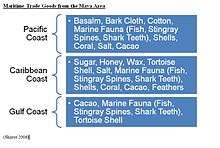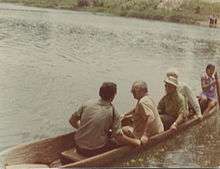Maritime trade in the Maya civilization

The extensive trade networks of the Ancient Maya contributed largely to the success of their civilization spanning three millennia. The Maya royals control and wide distribution of foreign and domestic commodities for both population sustenance and social affluence are hallmarks of the Maya visible throughout much of the iconography found in the archaeological record. In particular, moderately long distance trade of foreign commodities from the Caribbean and Gulf Coasts provided the larger inland Maya cities with the resources they needed to sustain settled population levels in the several thousands. Though the ruling class essentially controlled the trade economy, a middle merchant class supervised import and export from cities and trade ports. Not much is known of the Maya merchant class; however, merchants of royal lineage are sometimes represented in the iconography. Notably, a canoe paddle often accompanies the royal merchant depictions, signifying their association with marine resources.[1] Water lilies are also a recognizable feature of Maya iconography, appearing on ceramics and murals in landlocked cities like Palenque where the lilies cannot grow, further indicating the important political symbolism of water connections.[2] The dugout style canoes of the Maya and other small watercraft are also represented in various codices, sometimes ferrying royal figures or deities. The rich tradition of maritime trade has continued into the modern era, exemplified by the resource exploitation of the coastal lagoons and cay locations along the Caribbean coast of Mexico, Belize, Guatemala, and Honduras.
Common Coastal Trade Commodities
One of the largest trade industries from the coast involved the establishment of salt mining.[3] Salt is a basic dietary requirement and is difficult to obtain in the interior landscape of Central America. In response to this need, salt workshops cropped up along coastal Maya regions practicing the sal cocida technique of boiling brine in ceramics pots. These salt workshops, such as those found at Ambergis Caye, Placencia Lagoon, and Punta Ycacos Lagoon in Belize, provided salt for dietary consumption as well as the salt packing of other subsistence resources, such as fish, for coastal-inland trade.
Salt trade was a commodity of both common and elite social groups, though the quality of the salt likely fell under regulation between the classes, with elite grade “white” salt imported from the coasts of the Yucatán peninsula.[4][5] Basic household commodities, such as subsistence items (maize, beans, fish, shellfish, sugar, honey, etc.), stone tools, manos and metates, textiles, and simple ceramic wares produced throughout the Maya sphere would also have made their way to the major port trade sites for regional distribution.
Elite Coastal Trade Commodities
The trade of elite goods exemplifies Maya complex economic phenomena. The control of elite Maya commodities trade from inland to coastal regions was pivotal in creating and reinforcing political rule. Accessibility to obsidian, seashells, stingray spines, master crafted ceramics, jadeite, cacao, textiles, quetzal feathers, and gold were limited to the top of the Maya social strata. Presence of these commodities at sites both inland and coastal suggests connections to elite persons and to larger regional city centers, whether through trade or occupational usage. Not all coastal sites were necessarily occupied primarily as settlements, instead acting as de facto ports of trade because of their strategic locations at river mouths. The major trade site of Moho Cay in southern Belize is one such specific port, where high quality chert and obsidian from interior obsidian outcrops in the Guatemalan highlands was amassed for distribution down the Belize River to large cities, like Tikal, during the Classic Period.[6]
Wild Cane Cay on the northern Belizean coast also operated as a trade port focused on foreign obsidian distribution. Seashells, particularly conch and spondylus, were prized for both ritual usage and elite adornment. Modern strontium isotope analysis provides a means for sourcing shells trade to interior Maya settlements. Likewise, stingray spines imported from the coast played a major role in royal Maya bloodletting rituals for communing with ancestors and deities.
There is evidence that gold and jade, either as a raw material or a manufactured product, was produced in only limited quantities in the Maya regional sphere. Many instances of these two rare elite goods traveled by long-distance trade from the Ishmo-Columbian region outside of the Maya cultural sphere. The goldworks and jade originated in Costa Rica and Ecuador and likely traded up through coastal Caribbean routes, as interior routes were largely impassable. Likewise, artifacts of Maya origin appear in the archaeological record throughout Isthmo-Colombia.[7][8]
Maya Canoes
The Maya polities lacked access to large beasts of burden for carrying trade commodities throughout their civilization, and instead relied on the labor of human porters. The comparative ease and swiftness of water transport for moving large quantities of goods played a role in the Maya reliance on waterborne trade. This was accomplished by a well-established dugout vessel building technology. The canoes were likely hollowed from large cedar trunks, possibly with the addition of nailed plants to extend their holding capacity, and made watertight with pitch, probably asphaltum.

As of yet, there have been no discoveries of an intact ancient Maya canoe, however artistic representations from prehistory as well as descriptions from Christopher Columbus' son, Ferdinand, provide rich details about what these vessels were like. Ferdinand tells of an encounter with a Maya Canoe in the Bay of Honduras near the Bay Islands during Columbus' fourth voyage in 1506. Bartolomé de las Casas describes the encounter:
"There arrived a canoe full of Indians, as long as a galley and eight feet wide. It was loaded with merchandise from the west, almost certainly from the land of Yucatan, for that was near there [the Bay Islands], a matter of thirty leagues or a little more. There was in the middle of the canoe a shelter [toldo] of palm matting, which they call petates in New Spain. Inside and under this were their women and children, possessions, and merchandise, so that neither rain nor sea water could wet anything. . . There were in the canoe up to twenty-five men."[9]
Murals and artifacts from Tikal and Chichen Itza depict Maya canoes, and canoe related artifacts, such as wooden paddles, have been recovered from sites like Moho Caye.[10][11]
Eventually, the intensification of maritime trade reliance aided in the collapse of interior Maya power regimes, shifting political influence to coastal polities such as Uxmal and Chichen Itza in the Terminal Classic. A seaborne trade economy would continue to dominate the Maya civilization until the period of European Contact.[12]
See also
References
- ↑ Foster, L. V. (2002). Handbook to life in the ancient Maya World, Infobase Publishing.
- ↑ Sabloff, J. A. (1994). The new archaeology and the ancient Maya, Macmillan.
- ↑ McKillop, H. I. (2005). In Search of Maya Sea Traders, Texas A&M University Press.
- ↑ MacKinnon, J. J. and S. M. Kepecs (1989). "Prehispanic saltmaking in Belize: New evidence." American Antiquity: 522-533.
- ↑ Valdez Jr, F. and S. B. Mock (1991). "Additional considerations for prehispanic saltmaking in Belize." American Antiquity: 520-525.
- ↑ Healy, P. F., et al. (1984). "Analysis of obsidian from Moho Cay, Belize: New evidence on Classic Maya trade routes." Science 225(4660): 414-417.
- ↑ Hoopes, J. W. (2005). "The emergence of social complexity in the Chibchan world of southern Central America and northern Colombia, AD 300–600." Journal of Archaeological Research 13(1): 1-47.
- ↑ Hoopes, J. W. and O. Fonseca (2003). "Goldwork and Chibchan identity: Endogenous change and diffuse unity in the Isthmo-Colombian area." Gold and Power in Ancient Costa Rica, Panama, and Colombia, Dumbarton Oaks, Washington, DC: 49-90.
- ↑ Thompson, J. E. S. (1949). "Canoes and navigation of the Maya and their neighbours." Journal of the Anthropological Institute of Great Britain and Ireland: 69-78.
- ↑ McKillop, H. I. (2005). In Search of Maya Sea Traders, Texas A&M University Press.
- ↑ McKillop, H. (2005) "Finds in Belize document Late Classic Maya salt making and canoe transport." Proceedings of the National Academy of Sciences of the United States of America 102(15): 5630-5634.
- ↑ Sharer, R. J. (2006). The Ancient Maya, Stanford University Press.
Further reading
- Cooke, R., et al. (2003). "Who crafted, exchanged, and displayed gold in Pre-Columbian Panama." Gold and power in Ancient Costa Rica, Panamá, and Colombia. Washington, DC: Dumbarton Oaks Research Library and Collection: 91-158.
- Flannery, K. V. and J. Marcus (2000). "Formative Mexican chiefdoms and the myth of the “Mother Culture”." Journal of Anthropological Archaeology 19(1): 1-37.
- Guderjan, T. H. (1995). "Maya settlement and trade of Ambergris Caye, Belize." Ancient Mesoamerica 6: 147-159.
- Quilter, J. (2004). The Golden Bridge of the Darien. Gold and Power in Ancient Costa Rica, Panama, and Colombia. . J. Q. a. J. W. Hoopes. Washington, DC., Dumbarton Oaks.
- Snarskis, M. J. (2003). "From jade to gold in Costa Rica: How, why and when." Gold and Power in the Intermediate Area, Dumbarton Oaks, Washington, DC: 159-204.